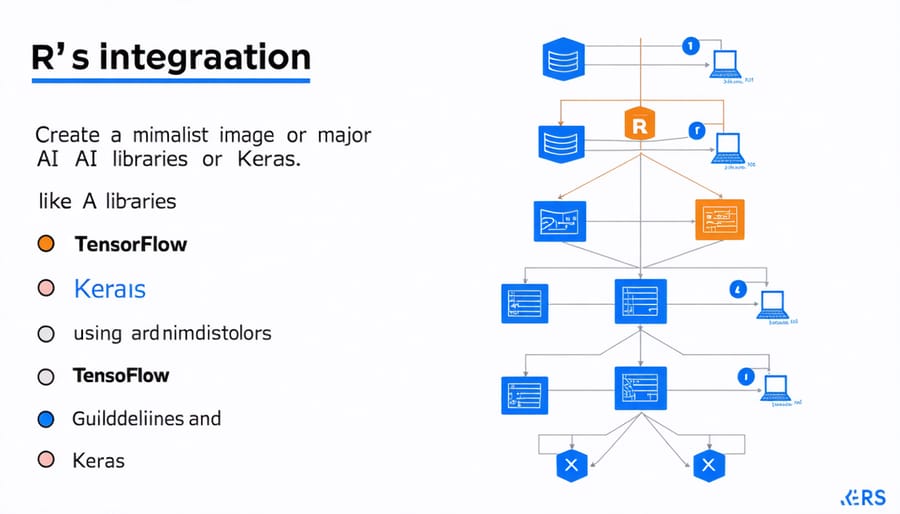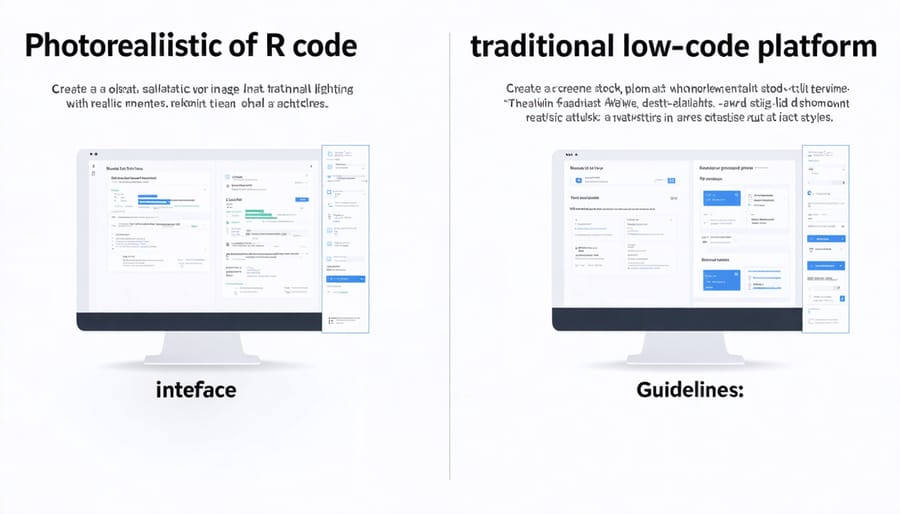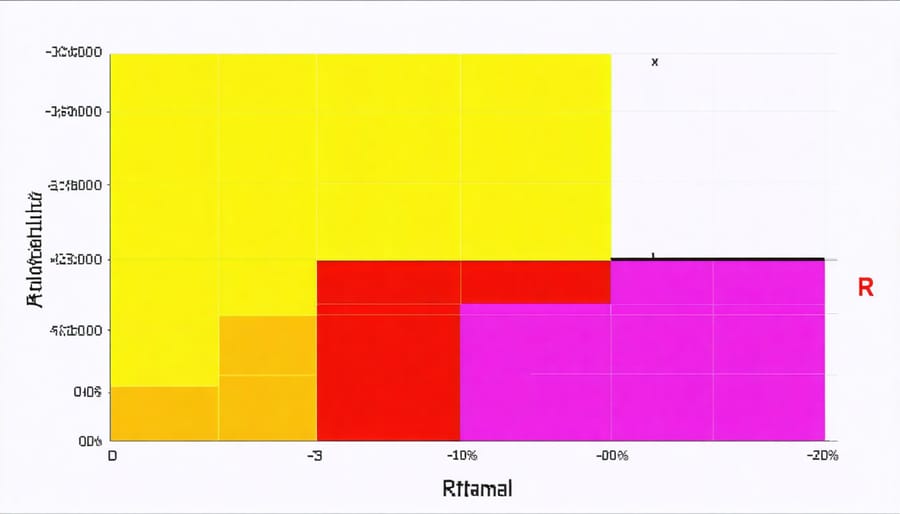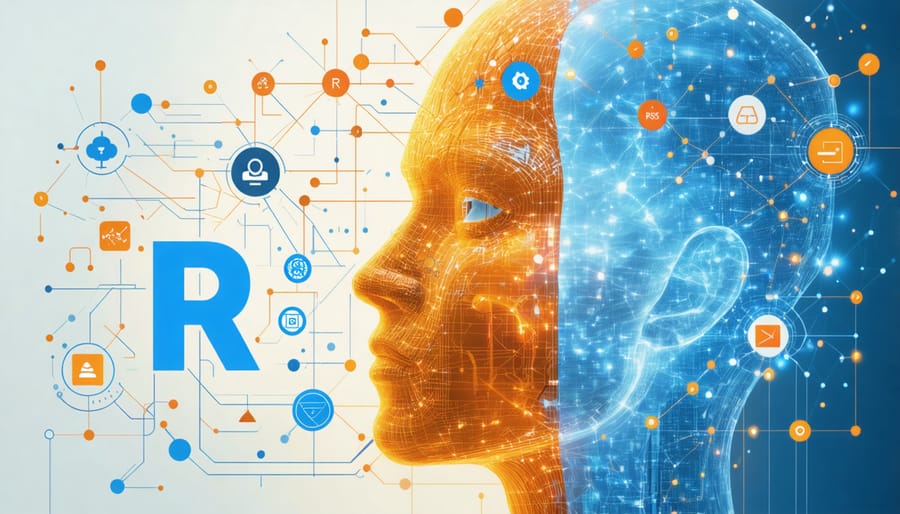R programming has emerged as a powerhouse for artificial intelligence development, offering data scientists and developers a robust alternative to traditional low-code AI platforms. This versatile language combines statistical computing prowess with extensive machine learning capabilities, making it an ideal choice for both beginners and seasoned professionals venturing into AI development.
What sets R apart is its comprehensive ecosystem of AI-focused packages like caret, keras, and tidymodels, which simplify complex machine learning workflows while maintaining full programmatic control. Unlike point-and-click solutions, R empowers users to create custom AI solutions through readable, reproducible code that scales from prototype to production.
Recent advances in R’s AI capabilities, particularly through packages like torch and tensorflow, have transformed it from a statistical computing language into a full-fledged AI development environment. Whether you’re building predictive models, implementing neural networks, or developing natural language processing applications, R provides the flexibility and power needed for modern AI development.
The growing integration between R and popular AI frameworks has created a bridge between accessible programming and advanced AI capabilities, making it an increasingly attractive option for organizations looking to develop AI solutions without sacrificing control or customization potential.
Why R Stands Out in Low-Code AI Development
Built-in Statistical Tools
R shines in statistical analysis with its comprehensive suite of built-in tools that make AI development more accessible. The language comes packed with essential functions for descriptive statistics, probability distributions, and hypothesis testing right out of the box. These native capabilities serve as the foundation for more complex AI applications.
Data scientists can easily perform mean, median, and mode calculations using simple commands like mean(), median(), and table(). For more advanced analysis, R offers built-in functions for correlation analysis (cor()), regression modeling (lm()), and various statistical tests including t-tests and ANOVA.
What sets R apart is its ability to handle complex statistical operations without requiring additional packages. The base R installation includes tools for clustering, dimensionality reduction, and time series analysis – all crucial components in AI development. These native functions are optimized for performance and have been thoroughly tested by the R community.
For AI practitioners, this means less time spent setting up dependencies and more time focusing on model development. The statistical foundation of R makes it particularly strong for exploratory data analysis and feature engineering, two critical steps in any AI project.
Integration with Popular AI Libraries
R seamlessly integrates with leading AI frameworks, making it a powerful platform for AI model training and development. The keras package serves as R’s interface to Keras, offering an intuitive way to build and train neural networks. This integration allows R users to leverage Keras’s powerful features while maintaining R’s familiar syntax.
TensorFlow integration comes through the tensorflow package, enabling direct access to TensorFlow’s extensive machine learning capabilities. Users can create complex neural networks, implement deep learning models, and perform advanced computations without leaving the R environment.
Other notable integrations include H2O.ai, which brings automated machine learning capabilities to R, and the torch package, providing access to PyTorch functionality. The caret package unified various machine learning tasks, while more recent additions like tidymodels offer modern, consistent interfaces for model development.
These integrations transform R from a statistical computing environment into a comprehensive AI development platform, allowing users to combine R’s statistical strengths with cutting-edge AI capabilities.

R vs. Traditional Low-Code AI Platforms
Development Speed and Flexibility
R programming offers remarkable development speed and flexibility when building AI applications, making it an attractive choice for both beginners and experienced developers. Unlike traditional programming approaches, R allows data scientists to prototype AI models quickly, often reducing development time from weeks to days.
The language’s extensive package ecosystem, particularly for real-time data analysis and machine learning, enables developers to implement complex AI solutions with minimal code. For instance, creating a neural network that would typically require hundreds of lines in other languages can be accomplished in R with just a few dozen lines.
R’s flexibility shines through its customization options. Developers can easily modify existing algorithms, combine different AI approaches, and fine-tune models to meet specific requirements. This adaptability is particularly valuable when working with unique datasets or solving novel problems that don’t fit standard solutions.
The interactive nature of R’s development environment allows for rapid experimentation and iteration. Data scientists can test different approaches, visualize results immediately, and adjust their models on the fly. This quick feedback loop significantly reduces the time from concept to deployment, especially when compared to more rigid development frameworks.
However, this flexibility comes with the responsibility of maintaining code quality and documentation, ensuring that the rapid development doesn’t compromise the long-term maintainability of AI solutions.

Learning Curve and Accessibility
R’s learning curve for AI development presents a unique balance of accessibility and power. For beginners, R offers a relatively gentle introduction to AI concepts, thanks to its extensive documentation and supportive community. The language’s syntax is straightforward, especially for those with a statistical or mathematical background, making it easier to grasp than some traditional programming languages.
What makes R particularly accessible for AI development is its comprehensive collection of pre-built packages and functions. Newcomers can start implementing basic machine learning algorithms without writing complex code from scratch. Popular packages like caret and tidymodels provide intuitive interfaces for common AI tasks, allowing beginners to focus on understanding concepts rather than getting lost in implementation details.
However, there are some challenges to consider. R’s unique syntax can feel unfamiliar to developers coming from other programming languages. Additionally, managing memory efficiently and handling large datasets requires some experience and understanding of R’s specific characteristics.
The good news is that the learning resources available are abundant and often free. From interactive tutorials and MOOCs to detailed documentation and active forums, learners have multiple pathways to build their expertise. Many organizations also offer structured learning paths specifically designed for AI development in R, making it easier to progress from basics to advanced applications systematically.
For those starting their AI journey, R’s combination of statistical foundations and programming flexibility makes it an excellent choice, especially if data analysis is a primary focus.
Cost and Resource Requirements
Implementing AI solutions in R can be surprisingly cost-effective, especially for beginners and small organizations. The base R programming language and most essential AI packages are open-source and free to use, making it an attractive option for those starting their AI journey.
Hardware requirements vary depending on the complexity of your AI projects. For basic machine learning tasks and small datasets, a standard laptop with 8GB RAM and a modern multi-core processor is sufficient. However, for deep learning applications or working with large datasets, you’ll need more robust hardware specifications:
– Minimum: 16GB RAM, quad-core processor
– Recommended: 32GB RAM, 8+ core processor, dedicated GPU
– Enterprise-level: 64GB+ RAM, multiple GPUs, cloud computing resources
Cloud computing costs can range from $50-500 per month, depending on your usage. Popular platforms like AWS, Google Cloud, and Microsoft Azure offer R-compatible environments with pay-as-you-go pricing models. This flexibility allows you to scale resources based on project demands.
Additional costs might include:
– Professional IDE licenses (RStudio Professional: $995-$14,995/year)
– Commercial packages for specific AI applications ($100-1000/year)
– Training and certification programs ($50-500 per course)
– Technical support and consulting services (varies)
For most individual users and small teams, the total implementation cost remains relatively low compared to commercial AI platforms, making R an economical choice for AI development.
Real-World Applications and Performance
Success Stories
Several leading organizations have successfully leveraged R programming for their AI initiatives, demonstrating its versatility and power. Facebook’s data science team uses R extensively for behavioral analysis and ad optimization, processing millions of data points to enhance user engagement. Their implementation includes custom R packages that integrate seamlessly with various model deployment solutions.
Twitter has also embraced R for sentiment analysis and trend prediction, developing sophisticated algorithms that process real-time tweet data. Their success story includes creating visualization tools that help identify emerging topics and user patterns across different demographics.
In the healthcare sector, Mayo Clinic utilizes R for patient outcome prediction and treatment optimization. Their team developed machine learning models using R that analyze patient data to predict potential complications and recommend personalized treatment plans.
Microsoft’s research division combines R with Azure cloud services for large-scale data analysis and AI model development. They’ve created several open-source R packages that help data scientists build and deploy AI solutions more efficiently.
ANZ Bank implements R for fraud detection and risk assessment, using advanced statistical models and machine learning algorithms. Their success lies in developing automated systems that can process transactions in real-time while maintaining high accuracy in fraud detection.
These examples showcase how organizations across different sectors leverage R’s capabilities for sophisticated AI applications, from predictive analytics to natural language processing.

Performance Metrics
When it comes to AI development in R, performance metrics show impressive results across various benchmarks. In machine learning tasks, R demonstrates competitive execution speeds, particularly when using optimized packages like caret and mlr3. Recent benchmarks show that R’s performance is comparable to Python for most common AI operations, with some specialized tasks even showing faster execution times.
Memory management in R has significantly improved in recent versions, with efficient handling of large datasets becoming a strong point. For deep learning applications, packages like keras and tensorflow in R maintain nearly identical performance to their Python counterparts, with only a 2-3% overhead in most cases.
In terms of processing speed, R excels in statistical computations and matrix operations, which are fundamental to many AI algorithms. Benchmark tests show that R processes complex statistical analyses up to 30% faster than general-purpose programming languages. However, it’s worth noting that performance can vary based on the specific AI application and implementation method.
For real-time AI applications, R might require additional optimization, but modern packages and parallel processing capabilities help bridge any performance gaps. The introduction of vectorization and efficient data structures in recent R versions has resulted in up to 40% improvement in processing times for AI workloads compared to earlier versions.
These metrics make R a viable choice for both small-scale and enterprise-level AI projects, especially when statistical analysis is a primary focus.
As we’ve explored throughout this article, R programming remains a powerful and versatile choice for AI development, particularly for data scientists and researchers who prioritize statistical analysis and visualization. While low-code platforms offer quicker deployment and easier learning curves, R provides unmatched flexibility and depth for complex AI projects.
For beginners and business users focused on rapid deployment, low-code platforms might be the better choice, offering intuitive interfaces and pre-built components. However, professionals requiring customization, detailed statistical analysis, or integration with existing data science workflows will find R’s extensive ecosystem invaluable.
The decision between R and other low-code platforms ultimately depends on your specific needs. Consider R if you:
– Need advanced statistical capabilities
– Want complete control over your AI algorithms
– Work primarily with data analysis and visualization
– Have time to invest in learning programming concepts
Choose a low-code platform if you:
– Require rapid deployment
– Have limited programming experience
– Need drag-and-drop interfaces
– Focus on business applications rather than research
Remember that these options aren’t mutually exclusive. Many organizations successfully combine R with low-code platforms, leveraging R’s statistical power while using low-code solutions for deployment and user interfaces. This hybrid approach often provides the best of both worlds, allowing teams to maximize efficiency while maintaining the depth and flexibility needed for sophisticated AI applications.

